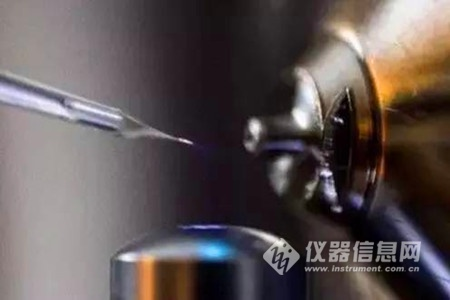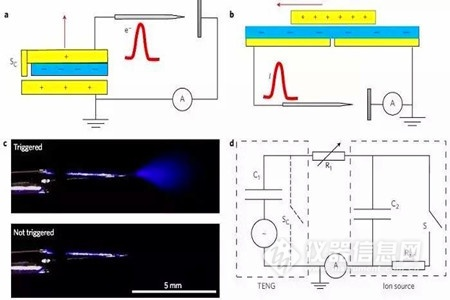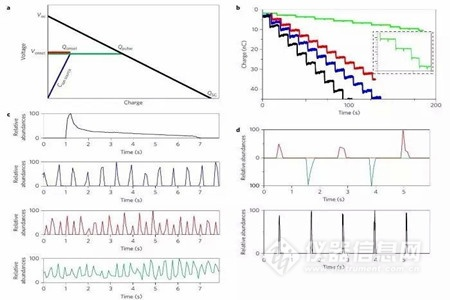Awesome! My mass spectrometer + friction nanogenerator
You may have a hard time connecting small nanogenerators to mass spectrometers, but how can smart scientists let go of any chance to solve problems? Let's start with a small wave of science about mass spectrometers:
The mass spectrometer is mainly composed of composition and structure analysis, which can accurately determine the molecular weight of the substance and structural analysis of the compound according to the characteristics of the fragment.
In the analysis, the molecules are first ionized, and then the properties of the ions moving in the electric or magnetic field are used to arrange the ions into spectra according to the mass-to-charge ratio. This is the mass spectrum. Then, by using the difference in mass-to-charge ratio of different ions, different molecules can be separated.
So the question is, how do you ionize a molecule? Simply put, it can be by means of loss or capture of a charge, such as electron emission, protonation or deprotonation.
But this step is not easy. First of all, the efficiency is very low, very low. If you use the traditional high-voltage power supply, 99% of the energy is wasted, it is money! More importantly, all current ionization None of the methods can accurately control the amount of ions, that is, the accuracy is not high. This is awkward!
Frictional nanogenerators have an important feature that enables high voltage output with a fixed charge. That is to say, if it can be combined with the mass spectrometer, not only can accurately control the number of ions to improve the accuracy, the energy consumption of the device will be greatly reduced, the instrument can be miniaturized, and then applied to aerospace and military fields.
It's easy to say, but solving this problem requires a top international team. Under the joint guidance of Academician Wang Zhonglin and Prof. Facundo Fernández of the Institute of Technology, Beijing Institute of Nano-Energy and Systems, Chinese Academy of Sciences, Dr. Ang Lee and Dr. Yunyun Long collaborated with the friction nano-generator (TENG) to drive the ion source and realize the ion source. The precise control of the amount of charge, positive and negative polarity, signal length, etc., published in Nature Nanotechonlogy, the clever ideas, precise control, please see below!
First, they used electro-spray ionization and plasma discharge ionization using a friction nanogenerator (TENG). The fixed amount of charge provided by TENG allows for unprecedented precise control of the ionization process and allows for controlled ion generation with nanocoloumb.
In addition, the sample consumption is greatly reduced. Through the driving of the nano-generator, the duration, frequency and chargeability of the ion pulse can be effectively controlled, so that the sample consumption can be minimized.
Compared with the traditional high-voltage technology, due to the small amount of charge generated by the nano-generator, the corona discharge phenomenon common in DC high voltage in mass spectrometry is avoided, and the ultra-high voltage (5-9 kV) nano-electrospray is realized for the first time. (nanoESI).
This Nature Nanotechonlogy provides a very detailed introduction to the work. The following is a simple graphic guide:

Figure 1. Image of an ion spray gun
The ion source generated by the friction nanogenerator is used to analyze extremely small quantities of chemical and biological samples with an accuracy of several hundred molecules.

Figure 2. Schematic diagram of ionization by TENG.
a) A mechanical illustration of a contact-separate friction generator (CS).
b) Mechanical diagram of an independent sliding friction generator (SF).
Yellow: Cu electrode layer
Blue: FEP layer ( ?uorinatedethylene propylene)
Red arrow: the direction of movement of the friction generator electrode
Pulse: the direction in which electrons move toward the ion source (e?, I)
Sharp needle: nano electric fog launching gun
Vertical square: steel plate for receiving electron beam, the current value can be measured with a pico ammeter ("A" in the figure)
c). The dark field image of the nano-electron launch gun can be seen as a feather-shaped electron beam emitted by the friction generator. The length unit is 1 mm.
d). In the equivalent circuit, TENG is represented by capacitor (C1) and other originals (left dotted frame). The nanoESI gun is equivalent to a capacitor (C2) and can emit a charge at a set value, indicated by the right dashed box. The emitted charge (generated ions) passes through the gap between the emitter and the mass spectrometer (or Piane ammeter A).
In addition, the CS-TENG electrode (a) is connected to one side, and the electrostatic state can be reset at the contact position, which is represented by a switch CS in FIG.

Figure 3. TENG for precise control of ionization of nanoelectron sprays
a) Representing TENGs to control the ion beam process The VOC-QSC line represents the voltage-charge relationship after TENGs provide a certain charge. When the nano-electrospray is connected, the charge is transferred to the ion source only when the voltage reaches a certain voltage Vonset.
Then, a large amount of charge is released in the form of ionization of electrospray until the TENG voltage drops below the set value, expressed by the green line Qpulse
b) The time-charge plot depicts the ionization pulse of a single CS-TENG driven nanospray emitter. The four wires are the result of using different resistors (0 GΩ (black), 0.5 GΩ (blue), 1 GΩ (red) and 1.25 GΩ (green)) to regulate the charge. The green line corresponds to a set condition, about 50% charge and can become an electronic spray.
c) Long-term or short-term total ion time record. Use SF-TENG to get on-demand high frequency pulses: >5 s (black), 600 ms (blue), 300 ms (red) and 60 ms (green).
d) Total ion time record of alternating polarity spray pulses (red + green) in one experiment. In one experiment and unipolar pulse (black) corrected in another experiment.
Nanogenerators can help mass spectrometers increase the sensitivity of electrospray ionization sources at low concentrations and maximize sample utilization. Moreover, the nanogenerators have successfully detected various small organic molecules and biomacromolecules. It is possible to detect the sensitivity of several hundred molecules. In addition, nano-generator-driven AC ion sprays can also be used to deposit ionic materials on insulating surfaces.
In fact, the significance of this research is not the case. This breakthrough is also groundbreaking for the friction nano-generator (TENG). This is the first time that nano-generators have been used in equipment and instruments, providing ideas for similar research in the future. . TENG replaces the original ion spray power supply on mass spectrometry equipment, making it portable for small mass spectrometry devices and providing applications under extreme conditions (such as military or aerospace), providing great convenience for space experiments.
Preferred Series Buchs,side table IKEA,stylish side table,modern style side table
Jiangmen Lihua Import & Export Trading Co., Ltd. Jiangmen Lihua Furniture., Ltd. , https://www.jmlihua.com